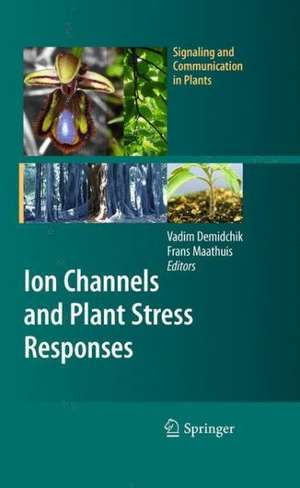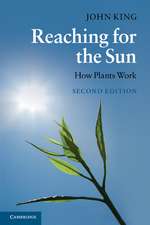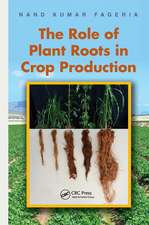Ion Channels and Plant Stress Responses: Signaling and Communication in Plants
Editat de Vadim Demidchik, Frans J. M. Maathuisen Limba Engleză Paperback – 4 mai 2012
| Toate formatele și edițiile | Preț | Express |
|---|---|---|
| Paperback (1) | 942.63 lei 6-8 săpt. | |
| Springer Berlin, Heidelberg – 4 mai 2012 | 942.63 lei 6-8 săpt. | |
| Hardback (1) | 946.55 lei 6-8 săpt. | |
| Springer Berlin, Heidelberg – 25 mar 2010 | 946.55 lei 6-8 săpt. |
Din seria Signaling and Communication in Plants
- 15%
 Preț: 641.71 lei
Preț: 641.71 lei - 24%
 Preț: 793.47 lei
Preț: 793.47 lei - 24%
 Preț: 1208.95 lei
Preț: 1208.95 lei - 18%
 Preț: 1118.13 lei
Preț: 1118.13 lei - 24%
 Preț: 783.53 lei
Preț: 783.53 lei - 18%
 Preț: 1111.53 lei
Preț: 1111.53 lei - 18%
 Preț: 998.34 lei
Preț: 998.34 lei - 18%
 Preț: 1545.57 lei
Preț: 1545.57 lei - 18%
 Preț: 1547.81 lei
Preț: 1547.81 lei - 18%
 Preț: 951.29 lei
Preț: 951.29 lei - 24%
 Preț: 796.83 lei
Preț: 796.83 lei - 18%
 Preț: 942.63 lei
Preț: 942.63 lei - 18%
 Preț: 1219.77 lei
Preț: 1219.77 lei - 18%
 Preț: 954.31 lei
Preț: 954.31 lei - 18%
 Preț: 953.20 lei
Preț: 953.20 lei - 18%
 Preț: 1388.05 lei
Preț: 1388.05 lei - 18%
 Preț: 956.50 lei
Preț: 956.50 lei - 18%
 Preț: 943.73 lei
Preț: 943.73 lei - 24%
 Preț: 1053.39 lei
Preț: 1053.39 lei - 18%
 Preț: 941.48 lei
Preț: 941.48 lei - 18%
 Preț: 943.57 lei
Preț: 943.57 lei - 18%
 Preț: 943.43 lei
Preț: 943.43 lei - 18%
 Preț: 944.51 lei
Preț: 944.51 lei - 18%
 Preț: 945.30 lei
Preț: 945.30 lei - 18%
 Preț: 1221.07 lei
Preț: 1221.07 lei - 18%
 Preț: 944.19 lei
Preț: 944.19 lei - 18%
 Preț: 948.92 lei
Preț: 948.92 lei
Preț: 942.63 lei
Preț vechi: 1149.54 lei
-18% Nou
Puncte Express: 1414
Preț estimativ în valută:
180.37€ • 188.83$ • 149.25£
180.37€ • 188.83$ • 149.25£
Carte tipărită la comandă
Livrare economică 07-21 aprilie
Preluare comenzi: 021 569.72.76
Specificații
ISBN-13: 9783642262951
ISBN-10: 3642262953
Pagini: 248
Ilustrații: X, 237 p. 28 illus., 15 illus. in color.
Dimensiuni: 155 x 235 x 13 mm
Greutate: 0.36 kg
Ediția:2010
Editura: Springer Berlin, Heidelberg
Colecția Springer
Seria Signaling and Communication in Plants
Locul publicării:Berlin, Heidelberg, Germany
ISBN-10: 3642262953
Pagini: 248
Ilustrații: X, 237 p. 28 illus., 15 illus. in color.
Dimensiuni: 155 x 235 x 13 mm
Greutate: 0.36 kg
Ediția:2010
Editura: Springer Berlin, Heidelberg
Colecția Springer
Seria Signaling and Communication in Plants
Locul publicării:Berlin, Heidelberg, Germany
Public țintă
ResearchCuprins
Ion Channels and Plant Stress: Past, Present, and Future.- The Role of Ion Channels in Plant Salt Tolerance.- Cation Channels and the Uptake of Radiocaesium by Plants.- Ion Channels in Plant Development.- Potassium and Potassium-Permeable Channels in Plant Salt Tolerance.- Regulation of Ion Channels by the Calcium Signaling Network in Plant Cells.- The Role of Cyclic Nucleotide-Gated Channels in Cation Nutrition and Abiotic Stress.- The Function of Cyclic Nucleotide-Gated Channels in Biotic Stress.- New Approaches to Study the Role of Ion Channels in Stress-Induced Signalling: Measuring Calcium Permeation in Plant Cells and Organelles Using Optical and Electrophysiological Techniques.- Vacuolar Ion Channels: Roles as Signalling Mechanisms and in Plant Nutrition.- Reactive Oxygen Species, Oxidative Stress and Plant Ion Channels.
Textul de pe ultima copertă
This book aims to provide a range of perspectives on an area that is very topical at present in plant biology: the role of ion channels in plant stress responses. Functions of cation and anion channels in the sensing and encoding of major biotic and abiotic stimuli, stress signal transduction and metabolism adjustment are examined at the cellular and molecular levels. Particular emphases of the book are on new insights into plant Ca2+ signaling, salinity tolerance mechanisms, cyclic nucleotide gated channels and the regulation of stress reactions among oxygen-derived species.
Caracteristici
This book reviews the molecular and physiological properties of ion channels in relation to their functional role in plant stress responses and presents novel hypotheses on mechanisms underlying the encoding and transduction of stress stimuli in plants. Includes supplementary material: sn.pub/extras









